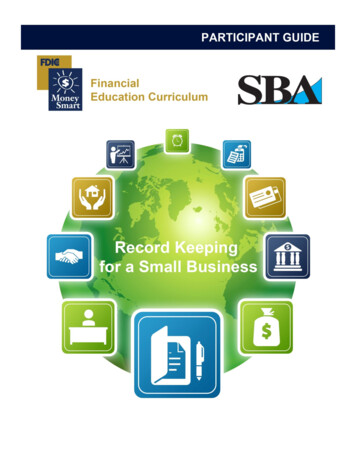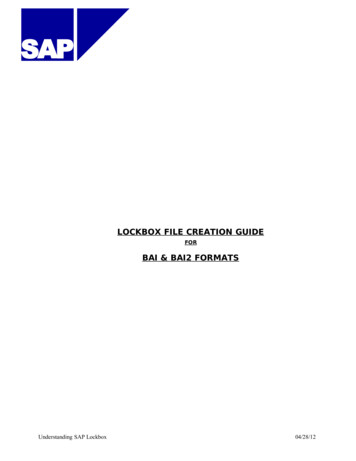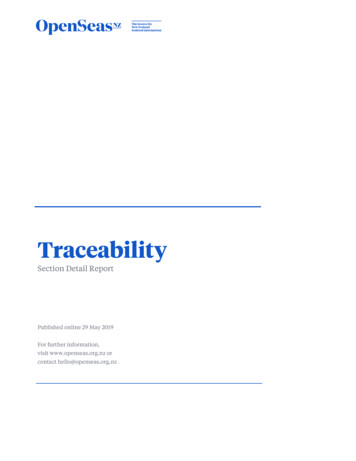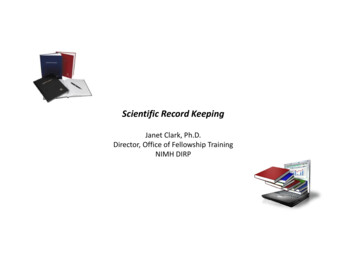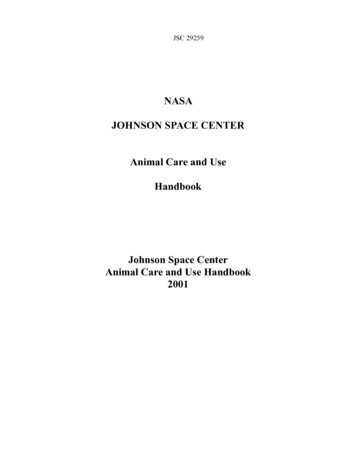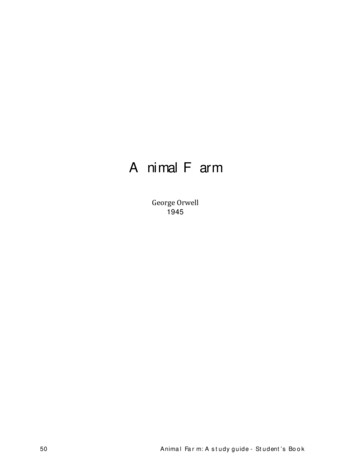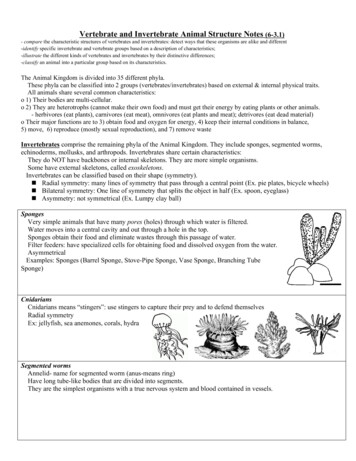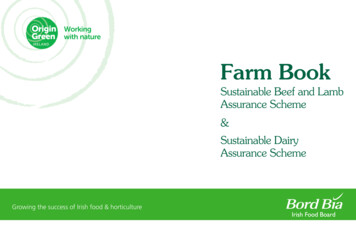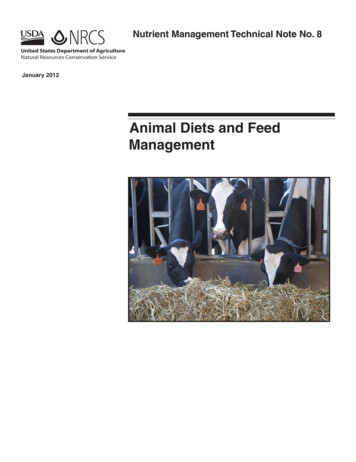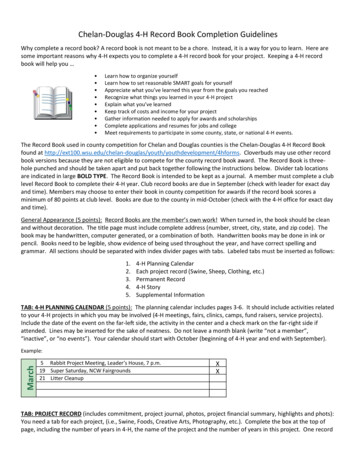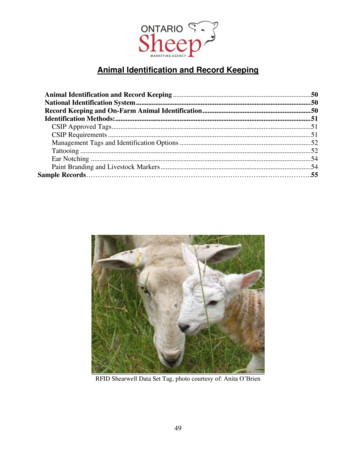
Transcription
Animal Identification and Record KeepingAnimal Identification and Record Keeping . 50National Identification System . 50Record Keeping and On-Farm Animal Identification . 50Identification Methods:. 51CSIP Approved Tags . 51CSIP Requirements . 51Management Tags and Identification Options . 52Tattooing . 52Ear Notching . 54Paint Branding and Livestock Markers . 54Sample Records . .55RFID Shearwell Data Set Tag, photo courtesy of: Anita O’Brien49
Chapter 4: Animal Identification and Record KeepingAnimal Identification and Record KeepingNational Identification SystemThe Canadian Sheep Identification Program (CSIP) is a mandatory national identification system,which is administered by the Canadian Sheep Federation (CSF). The program was designed to addressproducer concerns about sheep health and meet consumer expectations for quality assurance and food safety.In addition, the program was designed to be affordable, simple, practical and reliable. Many livestockcommodity groups are implementing similar tracking systems to improve food safety and to help containdisease outbreaks if they occur. The identification system for the sheep industry involves tagging all animalswith approved, individually numbered tags before they leave their farm of origin. Producers are required tobuy tags from a recognized agent. The series of numbers purchased by each producer is recorded. If aproblem is detected with a carcass at slaughter, the tag will help to track the animal’s origin and determineother animals it may have been in contact with. Tags are only read if a problem is detected with the carcass.As mentioned above, tagging for the national ID system is only necessary for the sale or purchase of animals.The tags are also mandatory for animals leaving the premises temporarily (e.g. exhibitions, veterinarianclinics, community pastures). If an animal is born and remains on your farm, tagging for the national systemis not required.The CSF is committed to ensuring that the CSIP evolves with the changing needs of producers andthe industry. One aspect of animal management is the development of genetic resource database and recordkeeping in the sheep industry to allow producers to improve the genetics of their flock through selectivebreeding. Carcass grading reports are also a valuable tool that should be developed and this trial will be ableto connect these details to the producer.The federal government has committed to having a national traceability program in place by 2015 toallow for the tracing and tracking of products and food animals from the point of origin (the farm) to theconsumer.The CSF has investigated a number of tracking options that would best suit the unique size andstructure of our industry, with Radio Frequency Identification (RFID) systems and electronic RFID ear tagsemerging as the best option currently available. The RFID system helps sheep producers meet traceabilityrequirements. The RFID system is also a powerful tool to collect, manage and analyze information for thepurpose of increasing production efficiency and productivity. Contact the Canadian Sheep Federation formore information about the National Identification system (888-684-7739) or go m/Tags/Tags.aspxRecord Keeping and On-Farm Animal IdentificationMaintaining performance records for your flock is one of the best management tools you can use toincrease the efficiency of your operation. Such factors as ram performance, weaning weights, lambingpercentage, and death losses have a direct effect on the income and profitability of your flock. All producersshould try to maintain some form of record keeping system. A very simple form of record keeping is to keeptrack of the number of ewes exposed to ram(s), the number of lambs born from those ewes, and the numberof lambs weaned. Monitoring even these very basic statistics will give a producer an idea of flockproductivity. Producers interested in making serious gains in productivity, however, will want to develop arecord keeping system to track the performance of individual animals. Maintaining records helps producerspinpoint areas of weakness in the overall flock performance, which will help when making decisions aboutflock management, the selection of new breeding stock and culling low performing animals. There areextensive computer management programs, such as Ewebyte, that are designed for use on sheep farms.Another major advantage of individually identifying stock is being able to track animals that have beentreated with medication. This helps ensure that animals are not shipped for slaughter before medicationwithdrawal times have been met and helps improve the efficiency of medication administration. Improvedtiming and tracking of medication use could potentially save on medication costs and decrease the likelihoodof developing resistant strains of bacteria on your farm.50
Chapter 4: Animal Identification and Record KeepingMaintaining records regarding medical histories of individual animals can also be used when makingculling decisions. For example, a ewe may have a tendency to prolapse while she is heavily pregnant butappear fine after lambing. As culling most likely won’t occur until after weaning, this information may beforgotten if not recorded.Currently, many producers have some method of on-farm identification. Many use a ‘permanent’system of identification, such as ear tags or tattoos, and/or a temporary system, such as livestock markers.Some producers use a combination of methods (e.g. permanently tagging breeding stock and use temporarymethods as needed for market lambs etc.). The sections below describe some of the more common means ofidentifying animals.Identification Methods:Canadian Sheep Identification Approved (CSIP) Approved TagsThe yellow Allflex button sheep tag and the yellow Shearwell data tag are the only Radio FrequencyIdentification (RFID) tags currently approved for use in the Canadian Sheep Identification Program (CSIP).As of October 2011, producers may no longer purchase pink Ketchum Kurl-Lock #3 and Allflexdangle tags as official CSIP tags however, sheep producers may use up their existing stocks of pink KetchumKurl-Lock tags until a future date is established when the tags will be revoked from the official CSIP list.Producers are encouraged to use up existing Kurl-lock tags as soon as possible before they are revoked, andto apply RFID tags to lambs born from 2012 onwards.Canadian Sheep Identification Program (CSIP) RequirementsUnder the current CSIP, producer and stakeholder responsibilities include: All sheep and lambs must bear an approved CSIP ear tag before they leave their farm of origin. Thisincludes animals leaving the premises temporarily (e.g. exhibitions, veterinarian clinics, communitypastures). It is illegal to transport animals not bearing an approved tag.CSIP tags must be purchased from an approved distributorSheep producers and feedlot operators are required to keep a record of:oAll sheep or lambs entering your flock for breeding purposesoAll sheep 18 months or older leaving your farm, other than those sold directly to a federallyor provincially inspected abattoirImported sheep must have an approved CSIP tag applied either before importation or within 7 daysof the sheep reaching its initial destination.All sheep purchased must bear an approved CSIP ear tag. If a tag is subsequently lost, you mustimmediately apply a new CSIP ear tag; report the new identification number and, if known, theformer identification number; and record information about the origin of the sheep as is known.Approved CSIP ear tags must not be removed from any live sheep or tampered with for any reasonand must not be re-used. If a sheep dies on your property, the tag may be removed. The identificationnumbers of the approved tags borne by the sheep carcasses disposed of by the operator must bereported within 30 days after disposing of the carcass. There are no record-keeping or reportingrequirements for the on-farm disposal of carcasses not bearing an approved tag.Auction marts, livestock dealers and packing plants are required to accept only sheep and lambsbearing an approved CSIP ear tag.Position the tag properlyPlace the tag 1/3 of the way along the ear away from the head, between the two main veins, with the maleend of the tag in back and the female in front. It is recommended to tag the RIGHT ear.In Ontario, tags may only be purchased through the Canadian Cooperative Wool Growers Limited 1-800567-3693.51
Chapter 4: Animal Identification and Record KeepingManagement Tags and Identification OptionsProducers may choose to use non-CSIP approved tags or identification methods for on-farmmanagement practices only, provided they meet CSIP requirements for animal identification when animalsleave their farm of origin.Management ear tags can be purchased in a variety of shapes and sizes. Small, aluminium ‘curllock’ tags and various types of plastic tags are often used for sheep. Tags can be purchased at most feedand/or farm equipment stores. You will also need a set of tagging pliers suitable for the type of tag you’vepurchased. Be sure to buy tags that are specifically designed for sheep. Cattle tags look similar, but aregenerally much larger.Advantages of using aluminium tags are that they are inexpensive and are rarely lost from the ear.The major disadvantage of these tags is that they are small and it is usually necessary to catch the animal toread the tag. This type of tag may become embedded in the ear if not applied properly. It is important whentagging lambs to place the tag near the outside of the ear. This allows room for the ear to grow. If the tagrestricts the growth of the ear it may cause an infection. Aluminium tags can be purchased in two sizes.There are very small lamb tags that may be used in newborn lambs for initial identification. They are placedin the ear shortly after birth or within the first two days of life. At three or four month of age the producerwill decide which animals will be kept as breeding stock. At that point lamb tags are often removed, as theear has outgrown the tag. Larger aluminium tags are available for older animals.Plastic tags are also widely used for identification. The plastic tags are easier to read withoutcatching the animals and are available is assorted colours. They can be purchased pre-stamped with numbersor blank, to be labelled as needed. The disadvantage of using plastic tags is that, depending on their design,they may have a relatively high rate of loss. As with the aluminum tags take care to allow for ear growthwhen using plastic curl-lock tags. When replacing tags, if possible, use the same hole that was made by theoriginal tag.Producers may use various methods of tagging to assist them in recognizing different groups ofsheep at a glance. As plastic tags come in different colours, each colour can be used to distinguish betweendifferent birth years, different breeds, commercial versus purebred animals, or male versus female. Otherproducers may use different series of numbers for various characteristics. These tagging schemes should bedesigned to help make sorting and identifying sheep easier in the particular farming operation.TattooingIn order to register purebred sheep in Canada, you must tattoo your animals with a unique identification.Some producers of commercial sheep may also prefer tattooing rather than ear tags, as tags may be lost. Forregistered purebred sheep the identification must include three components: farm flock letters, animalidentification, and the year letter. Registered flock letters are obtained from the Canadian Livestock RecordsCorporation (CLRC) in Ottawa. All purebred animals on the farm will be given the same flock letters.Producers assign individual animals a number that is unique within the flock. All animals born within thesame year are assigned a year letter. All flocks use the same year letter. A typical purebred identification isas follows: TAG 25GTAG(flock letters)25(animal number -unique within the flock)Gyear letter (born in 1997)Flock letters are tattooed in the right ear of the sheep, and the animal number and year letter are tattooed inthe left earTattoo Year LettersLetters that could be difficult to read or misinterpreted as a number are not used for year letters (i.e. ‘I’, ‘O’,‘Q’, and ‘V’ are not used)52
Chapter 4: Animal Identification and Record 62017201820192020To tattoo sheep you need tattooing pliers, a double set of numbers (0 to 9), the current year letter, andyour flock letters. Pliers can generally be purchased at feed stores and farm equipment stores. There are twobasic types of pliers: a revolving head model (one set of symbols on either side of a pivoting head) and singlepliers (one set of symbols on stationary head). With the revolving head model, you can place the flock letterson one side of the plier head and the animal number and year letter on the other side. These pliers areconvenient as you can do one animal without having to stop to change symbols. However, you must becareful to keep the revolving head snugly in place or the pliers will twist during tattooing, resulting in a poortattoo. If you use single pliers it is most convenient to have two sets. This allows you to leave the flockletters in one set and use the other set for the animal number and year letter. For purebred registration, lambsmust be tattooed by four months of age. Very small tattoo pliers are available for tattooing very young lambs(one to two weeks of age). The tattoo will grow with the ear as the lamb grows.Procedure for Tattooing:1. The inside of the ears should be wiped free of dirt, grease, and wax before tattooing.2. Insert the required letters and/or numbers in the jaws of the pliers and lock into position.3. Check the correctness of the symbols by making an imprint on a piece of paper or corrugatedcardboard. It is quite easy to reverse symbols, resulting in difficult to read tattoos. Remember, yourmistakes will be permanent.4. Secure the animal so that unnecessary movement is avoided. It is advisable to have an assistant.Animals can be turned on their rump or held in a chute to facilitate handling.5. Smear the ink or paste on the area to be tattooed. Black or green ink will work well for white-earedanimal. Green ink is most legible for black or dark-eared animals. Using paste rather than inkresults in a clearer and longer lasting tattoo.6. The tattoo should be placed between the main veins of the ear. Make the imprint with a quick firmmovement. Extreme pressure is not needed.7. Withdrawal the pliers and immediately apply ink to the tattoo. Vigorously rub the area with a brushor your thumb and forefinger continuously for at least 15 seconds. This is an important step inachieving a clear tattoo.8. Some bleeding may occur. If so, continue to rub tattoo paste or ink into the area. Tattoo paste andink have antiseptic qualities.9. After tattooing is complete, remove excess pigment from the pliers and symbols by scrubbing themin warm, soapy water with a stiff-bristle brush and dry. Immerse the equipment in rubbing alcohol,replace to their containers, and store in a clean, secure location.10. Do not disturb the tattooed area until healing is complete. This may be from 5-21 days depending onthe age and breed of the animal.Tip: In a dimly lit area, hold a flashlight behind the tattoo to read the numbers for dark-eared animals.53
Chapter 4: Animal Identification and Record KeepingEar NotchingSome producers may wish to ear-notching lambs at birth. Ear notching involves punching small holesalong the sides of the ears at specific locations based on a coding system. There is a universal coding systemthat may be used, or the system can be tailored to suit the needs of the individual farm. This is a permanentidentification system, which also means that the mistakes will also be permanent. Theoretically, animals donot have to be caught to read the identification. However, it takes practice to read the notches quickly.Paint Branding and Livestock MarkersRather than tagging newborn lambs, some producers prefer to paint brand lambs at birth. Lambs areoften paint branded with the same number as their mother. This allows for easy matching of ewes with theirlambs. Branding irons with the numbers 0-9 are available for dipping in scrubbable paint for this purpose.The paint brand can last up to 12 months under ideal circumstances. Scrubbable paint in spray cans is alsoavailable.Crayon livestock markers are available for short-term animal identification. For example, if a few lambsin a pen were treated with antibiotics the producer may use a marker to visually identify those lambs.When using livestock paints or markers only use non-toxic materials intended for use onlivestock. As well as causing possible health problems for the sheep, using inappropriate materials can be afood safety issue. These materials should also be scrubbable (removable from the fleece). Place the markerin the head or neck of the animals rather than the back or loin area when using markers or paint on animalsnear the time they will be shipped for slaughter.Sample Records:The next few pages show examples of the type of records that you may wish to keep for your flock. Adapt toown farm. Lambing diaries are available from OSMA or OMAF. The SFIP program provides a means oftracking lamb growth and genetic progress of the flock. As noted above, for people who prefer to keepelectronic records, there is a computer management program designed for use on sheep farms.54
Chapter 4. Animal Identification and Record Keeping - Sample RecordsEwe RecordEwe Identification:Breed:Birth Date:Sire:Dam:Type of Birth:Birth Weight:Weaning Weight:Yearling Weight:Comments (purchase/sale information, temperament):(Note: enter a new line for each lamb in the litter)DateSex ofBirthType of BirthLambedLambWeight(single, twin etc.)Born asWeaningDateRaised as55WeaningWeightYearlingWeightComments (ease of birth, complications, etc.)
Chapter 4. Animal Identification and Record Keeping - Sample RecordsFlock Health RecordTreatmentDate(d/m/y)Animal or PenIdentificationCondition treatedand/or signsProductNamePrescription (P) or Nonprescription (NP)DoseEstimated AnimalWeight/Number of hdrawal(date safe toship toslaughter orauction)*Route Codes: IW- In the Water IF- In the feedTT- Topical treatment (pour-on) OR- OralSQ-SubcutaneousIM- Intramuscular IV-IntravenousNote: If a needle breaks in an animal during an injection, record the animal’s identification number, location of the needle and date it occurred in the commentssectionComments: Producer’s Signature:Date:56
Chapter 4. Animal Identification and Record Keeping - Sample RecordsBreeding RecordRam Identification:First day of breeding season(date ram turned out)Lambing %(total live lambs/total ewes exposed)Comments:Ewe IDMarked 1stcycle?*Ram Breed:Last day of breeding season:Ram Birth Date:Total number of Ewes(current breeding season)Average market weight(all lambs)Average weaning weight(all lambs):Marked 2ndcycle?*Lambing Date# of lambsAverage birthwt*i.e. Ram fitted with a marking harness with new colour marker added every 17 days of the season57Average daysto marketAveragemarket wtComments
Chapter 4. Animal Identification and Record Keeping - Sample RecordsLamb Mortality RecordAnimal IDDate of deathAge oflambWeaned?(Y/N)Prior signs of illness (e.g. respiratory distress, offfeed, wasting, etc.)58Cause confirmed?(e.g. post mortem finding)
Chapter 4. Animal Identification and Record Keeping - Sample RecordsBreeding Stock Mortality/Culling RecordAnimal IDAnimalAgeDate ofdeath/cullingDied onFarm?(Y/N)Reason for culling or suspectedcause of death59Prior signs of illness (e.g.respiratory stress, off-feed,wasting, etc.)Cause confirmed?(e.g. post mortem finding)
Chapter 4: Animal Identification and Record Keeping 52 Management Tags and Identification Options Producers may choose to use non-CSIP approved tags or identification methods for on-farm management practices only, provided they meet CSIP requirements for animal identification
